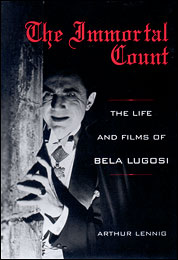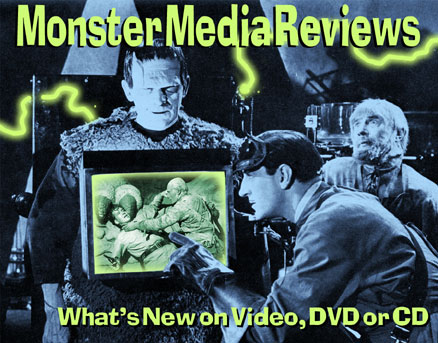 The
Immortal Count The
Immortal Count
The Life and Films of Bela Lugosi
by Arthur Lennig
University Press of Kentucky
"He'll be back."
No, no one really
said that at Bela Lugosi's funeral in 1956, but those apocryphal
words have turned out to be truer than even the most dedicated
Lugosiphile could have imagined. Even as technologies and tastes
change, the awkward Hungarian seems downright eternal, relentlessly
celebrated almost 50 years later in documentaries, magazines,
soundtracks, DVDs, books and CD-ROMs. Bela, it seems, never
left the building at all.
Some of the work
has been groundbreaking: Gary Don Rhodes, David Skal, Frank
Dello Stritto, Gregory Mank, Tom Weaver and many others have
all interviewed co-stars and stagehands, uncovered lost contracts,
visited catacombs in Transylvania or pored over newspaper clippings
in Prague. Rhodes, in particular, has been the Woodward and
Bernstein of Lugosi research.
Now one of the original
Lugosi scholars, Arthur Lennig, has revisited the entire Lugosi
mythos with what must stand, for now, as the definitive biography,
THE IMMORTAL COUNT: The Life and Films of Bela Lugosi.
Originally published in 1974, this revised version is twice
the length and takes Lennig back through everything -- including
his own research -- to trace once again the Lugosi legend, from
aspiring actor and almost-idol in Europe to exile and rebirth
in America as an icon of the undead.
From forgotten
newspaper notices of Bela's earliest years in Hungary to his
politics, his wives, his attempts to escape his monstrous image
and onward through his vague years in the early 50s, Lennig
portrays an actor who came to America not as a teenager but
as a working adult, a Balkan stranger in a strange land who
was more level-headed about his profession and his aspirations
than is widely believed. New details about Lugosi's earliest
years at Universal confirm growing evidence that it was James
Whale, and not Lugosi's pride, that kept him from playing the
Frankenstein monster. Lennig posits that despite Lugosi's objections,
he would have been perfectly willing to play the monster. As
Lugosi said to one of his interviewers, "I make a living."
Lennig cites a legion
of fans and researchers to uncover lost years and debunk what
many thought was central to the Lugosi mythos up to now: Yes,
Lugosi was frustrated, but the life portrayed here is far rosier
than a vampire might deserve. Lugosi's financial difficulties
were deep but infrequent. Sinatra did try to help Bela in his
later years, but Lugosi worked more than many suppose and lived
quite well. The estrangement between Bela and his son was deeper
than has been revealed, and court documents open a raw look
at family distrust and struggles over legacies and fame.
 The
work is compelling because of the journalistic style. Page by
page, year by year, footnote by footnote, you feel you're getting
the real deal. In fact, the book is so thoroughly researched
that on those few rare occasions where Lennig steps into horror
fan advocacy, the shift is downright jarring. Lennig unaccountably
fills in the blanks at times, putting motives or beliefs into
Lugosi's head, based apparently on the weight of Lennig's lifetime
acquaintance with the subject. If there are two sides to a dispute,
he usually picks Bela's version. He minimizes Lugosi's drug
use on movie sets, which has raised some eyebrows among witnesses.
And he so passionately defends some of Bela's films or roles
that he gets testy with writers who hold different views. It
all feels out of place in a book where facts, not opinions,
are carrying the day. The
work is compelling because of the journalistic style. Page by
page, year by year, footnote by footnote, you feel you're getting
the real deal. In fact, the book is so thoroughly researched
that on those few rare occasions where Lennig steps into horror
fan advocacy, the shift is downright jarring. Lennig unaccountably
fills in the blanks at times, putting motives or beliefs into
Lugosi's head, based apparently on the weight of Lennig's lifetime
acquaintance with the subject. If there are two sides to a dispute,
he usually picks Bela's version. He minimizes Lugosi's drug
use on movie sets, which has raised some eyebrows among witnesses.
And he so passionately defends some of Bela's films or roles
that he gets testy with writers who hold different views. It
all feels out of place in a book where facts, not opinions,
are carrying the day.
Those looking for
something truly eye-opening will be riveted by the final chapters,
where there is a gripping series of encounters with Bela's last
wife, Hope (who also can be seen in Rhodes' DVD documentary),
and a fierce take on Bela Lugosi Jr., who is portrayed as only
interested in his late dad as product. I don't doubt Lennig's
characterizations -- young Bela does NOT come across well --
but I ached to hear Lugosi Jr.'s version of it all. Yes, the
son of Dracula declined to participate, and Lennig does rely
upon public records. But even a friend of Lugosi Jr.'s point
of view might have been a nice bit of balance.
Still, these are
quibbles because the work itself is a monumental and lifelong
job of research and investigation. Even with his occasional
knocks at other writers, he generously and repeatedly credits
their work, and the footnotes are voluminous and impressive.
And while it threw me a bit, in truth who more deserves to have
an opinion about Lugosi than Lennig, who met Lugosi as a child
and never lost his fascination?
The book is somewhat
pricey -- $35 -- but it is a cornerstone of any horror collection,
let alone a Lugosi library. The book is available from the University
Press of Kentucky or amazon.com and Lugosiphiles
should not let another walpurgis come and go without it.
Or, as a very old
man said a long time ago, "Excellent, Mr. Renfield. Excellent."
David Colton
David can be reached
at taraco@aol.com
|

